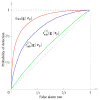Application of the Hotelling and ideal observers to detection and localization of exoplanets
- PMID: 18059905
- PMCID: PMC2596684
- DOI: 10.1364/josaa.24.000b13
Application of the Hotelling and ideal observers to detection and localization of exoplanets
Abstract
The ideal linear discriminant or Hotelling observer is widely used for detection tasks and image-quality assessment in medical imaging, but it has had little application in other imaging fields. We apply it to detection of planets outside of our solar system with long-exposure images obtained from ground-based or space-based telescopes. The statistical limitations in this problem include Poisson noise arising mainly from the host star, electronic noise in the image detector, randomness or uncertainty in the point-spread function (PSF) of the telescope, and possibly a random background. PSF randomness is reduced but not eliminated by the use of adaptive optics. We concentrate here on the effects of Poisson and electronic noise, but we also show how to extend the calculation to include a random PSF. For the case where the PSF is known exactly, we compare the Hotelling observer to other observers commonly used for planet detection; comparison is based on receiver operating characteristic (ROC) and localization ROC (LROC) curves.
Figures







Similar articles
-
Spatio-temporal Hotelling observer for signal detection from image sequences.Opt Express. 2009 Jun 22;17(13):10946-58. doi: 10.1364/oe.17.010946. Opt Express. 2009. PMID: 19550494 Free PMC article.
-
Estimation receiver operating characteristic curve and ideal observers for combined detection/estimation tasks.J Opt Soc Am A Opt Image Sci Vis. 2007 Dec;24(12):B91-8. doi: 10.1364/josaa.24.000b91. J Opt Soc Am A Opt Image Sci Vis. 2007. PMID: 18059918 Free PMC article.
-
Objective assessment of image quality. IV. Application to adaptive optics.J Opt Soc Am A Opt Image Sci Vis. 2006 Dec;23(12):3080-105. doi: 10.1364/josaa.23.003080. J Opt Soc Am A Opt Image Sci Vis. 2006. PMID: 17106464 Free PMC article.
-
The application of interferometry to optical astronomical imaging.Philos Trans A Math Phys Eng Sci. 2002 May 15;360(1794):969-86. doi: 10.1098/rsta.2001.0977. Philos Trans A Math Phys Eng Sci. 2002. PMID: 12804289 Review.
-
Subaru Telescope -History, active/adaptive optics, instruments, and scientific achievements.Proc Jpn Acad Ser B Phys Biol Sci. 2021;97(7):337-370. doi: 10.2183/pjab.97.019. Proc Jpn Acad Ser B Phys Biol Sci. 2021. PMID: 34380914 Free PMC article. Review.
Cited by
-
Objective assessment of image quality. V. Photon-counting detectors and list-mode data.J Opt Soc Am A Opt Image Sci Vis. 2012 Jun 1;29(6):1003-16. doi: 10.1364/JOSAA.29.001003. J Opt Soc Am A Opt Image Sci Vis. 2012. PMID: 22673432 Free PMC article.
-
Multivariate Analysis under Indeterminacy: An Application to Chemical Content Data.J Anal Methods Chem. 2020 Jul 11;2020:1406028. doi: 10.1155/2020/1406028. eCollection 2020. J Anal Methods Chem. 2020. PMID: 32733737 Free PMC article.
-
On Advanced Estimation Techniques for Exoplanet Detection and Characterization Using Ground-based Coronagraphs.Proc SPIE Int Soc Opt Eng. 2012 Jul 1;8447:844722. doi: 10.1117/12.925099. Proc SPIE Int Soc Opt Eng. 2012. PMID: 26347393 Free PMC article.
-
Spatio-temporal Hotelling observer for signal detection from image sequences.Opt Express. 2009 Jun 22;17(13):10946-58. doi: 10.1364/oe.17.010946. Opt Express. 2009. PMID: 19550494 Free PMC article.
References
-
- Barrett HH, Myers KJ. Foundations of Image Science. Wiley-Interscience; 2004.
-
- The extrasolar planets encyclopaedia. http://exoplanet.eu/
-
- Babcock HW. The possibility of compensating astronomical seeing. Publ Astron Soc Pac. 1953;65:229–236.
-
- Tyson RK. Principles of Adaptive Optics. Academic; 1998.
-
- Macintosh BA, Graham J, Poyneer L, Sommargren G, Wilhelmsen J, Gavel D, Jones S, Kalas P, Lloyd JP, Makidon R, Olivier S, Palmer D, Patience J, Perrin M, Severson S, Sheinis A, Sivaramakrishnan A, Troy M, Wallace JK. Extreme adaptive optics planet imager: XAOPI. Proc SPIE. 2003;5170:272–282.
Publication types
MeSH terms
Grants and funding
LinkOut - more resources
Full Text Sources

